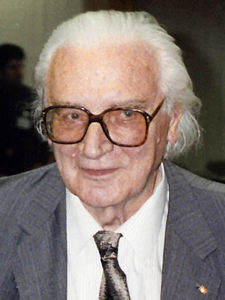Konrad Zuse: Difference between revisions
imported>Pat Palmer (linking to Zuse image) |
mNo edit summary |
||
| (6 intermediate revisions by 2 users not shown) | |||
| Line 1: | Line 1: | ||
{{subpages}} | {{subpages}} | ||
{{Image|Konrad Zuse (1992).jpg|right|225px|Konrad Zuse in 1992}} | |||
'''Konrad Zuse''' (1910-1995) was an under-credited but highly fruitful German computer designer. Working in relative isolation in pre-war [[Germany]], Zuse built three prototype electronic computers (V1, V2 and V3) which computed using the [[binary numeral system]] and other advanced design concepts. Zuse's third model, the Z3, was completed well before any of the celebrated early American computers, and though seldom credited as such, almost certainly deserves to be recognized to be the first modern electronic computer. However, Zuse was in a chaotic German wartime environment and lacked official support, and all three of the working models were destroyed during [[World War II]]<ref name="Zuse1">{{cite book|url=http://www.amazon.com/Portraits-Silicon-Robert-Slater/dp/0262691310|title="Portraits in Silicon" by Robert Slater, ch. 5, p. 43|publisher=The MIT Press|year=1987}}</ref>. | |||
Despite being drafted into the German army, Zuse survived the war, built another computer in Switzerland (the V4), and later was the first designer to propose [[pipelining]] the computations of a computer [[CPU|processor]]. In 1949, Zuse formed Zuse KG, where he worked until 1966. Zuse KG grew into a leading manufacturer of small scientific computers, employing a thousand people<ref name="Zuse2">{{cite book|url=http://www.amazon.com/Portraits-Silicon-Robert-Slater/dp/0262691310|title="Portraits in Silicon" by Robert Slater, ch. 5, p. 50|publisher=The MIT Press|year=1987}}</ref>. | |||
==References== | ==References== | ||
<references/> | <references/>[[Category:Suggestion Bot Tag]] | ||
Latest revision as of 16:01, 8 September 2024
Konrad Zuse (1910-1995) was an under-credited but highly fruitful German computer designer. Working in relative isolation in pre-war Germany, Zuse built three prototype electronic computers (V1, V2 and V3) which computed using the binary numeral system and other advanced design concepts. Zuse's third model, the Z3, was completed well before any of the celebrated early American computers, and though seldom credited as such, almost certainly deserves to be recognized to be the first modern electronic computer. However, Zuse was in a chaotic German wartime environment and lacked official support, and all three of the working models were destroyed during World War II[1].
Despite being drafted into the German army, Zuse survived the war, built another computer in Switzerland (the V4), and later was the first designer to propose pipelining the computations of a computer processor. In 1949, Zuse formed Zuse KG, where he worked until 1966. Zuse KG grew into a leading manufacturer of small scientific computers, employing a thousand people[2].
References
- ↑ (1987) "Portraits in Silicon" by Robert Slater, ch. 5, p. 43. The MIT Press.
- ↑ (1987) "Portraits in Silicon" by Robert Slater, ch. 5, p. 50. The MIT Press.
